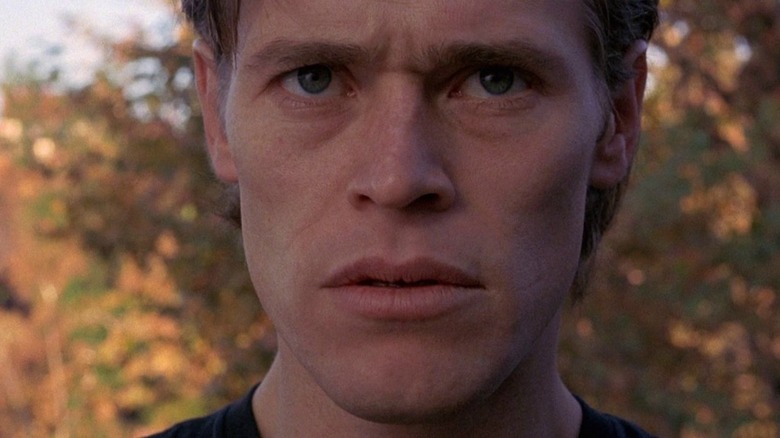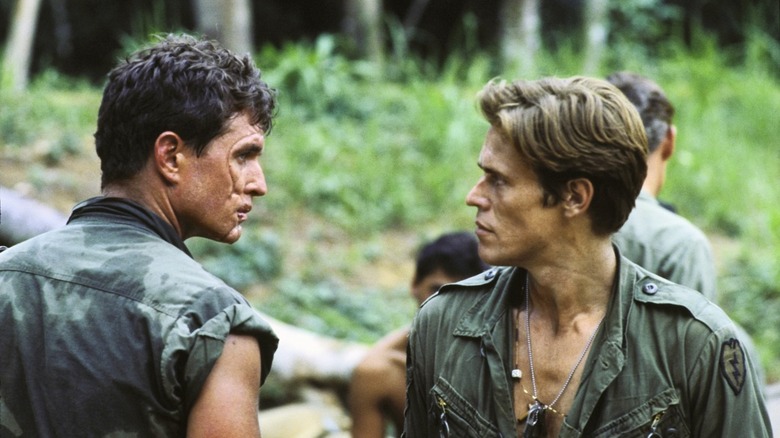Playing To Live And Die In L.A.'s Villain Led To Willem Dafoe Getting His More Positive Role In Platoon
Willem Dafoe has that rare energy as an actor where you could see him playing a benevolent and angelic character just as easily as you could see him playing an outright villain. Since his first screen appearance in 1980 in a background role as a cockfighter in Michael Cimino's troubled epic "Heaven's Gate," Dafoe has racked up close to 150 credits. That's at least three per year — a far less common rate now that studios no longer have the power to work their stars into the ground. Dafoe's stardom is more akin to the New Hollywood hotshots that emerged in the '60s and '70s (think Henry Fonda or Faye Dunaway) than those celestial bodies of the classic era. He's always prioritized getting deep into a challenging character over playing admirable and attractive heroes.
In those 40-some years, he's played roles as wicked as the lecherous, greased-up gangster Bobby Peru in "Wild At Heart" and as virtuous as, literally, Jesus Christ in "The Last Temptation of Christ." It seems that Dafoe's exceptional range, his ability to tap into the purest and most corrupt forces that propel us as human beings, not only worked against him being type-cast, but actually led directors to think of him for roles.
Case in point: In a 2011 interview with Entertainment Weekly to mark the 25-year anniversary of his Vietnam War classic "Platoon," writer-director Oliver Stone noted that it was Dafoe's villainous appearance in "To Live and Die in L.A." that led him to think of the actor for the much more virtuous Sgt. Elias.
Heroes and villains
Scripted and directed by William Friedkin, "To Live and Die in L.A." follows the antic pursuit of two secret service agents assigned to a counterfeiting sting. Their target: the icy, amoral, genuinely unpredictable counterfeit artist Rick Masters, played by Willem Dafoe. By this point, Dafoe was no stranger to films that positioned themselves as cult classics from the very beginning. His first major screen role was in Kathryn Bigelow's homage to bikesploitation flicks, "The Loveless," and the endlessly cool David Bowie/Catherine Deneuve vampire film "The Hunger." But "To Live and Die in L.A." was something different. Dafoe was given command of the screen, and he took up every possible inch with his menacing, subversively queer-coded performance as Masters.
In his interview with Entertainment Weekly, Oliver Stone remembered taking notice. When asked if he had first considered Jeff Bridges for the role of the kind yet tragic Sgt. Elias, Stone noted, "Quite possibly, I don't recall. I liked Willem because I'd seen him as a bad guy in 'To Live and Die in L.A.' and I liked the idea of him being a more positive character."
"Platoon" was Stone's first directorial effort, and his first attempt to deal with his experience in the Vietnam War head-on. The film centers on the antagonistic relationship between the innocent Army volunteer Chris Taylor (Charlie Sheen) and the murderous, out-of-control commanding Sgt. Barnes (Tom Berenger). Dafoe's character tries to reconcile their conflict to tragic ends: Barnes shoots him in the back in cold blood, and then tries to pin his murder on the Vietnamese.
In an interview with Harry Connick Jr., Dafoe shared that in fact, no one knew what roles they'd be playing until they showed up on set in the Philippines. But it's hard to imagine a more perfect encapsulation of Dafoe's range than going from one of the most menacing villains of the '80s to one of its most heartbreaking martyrs.

